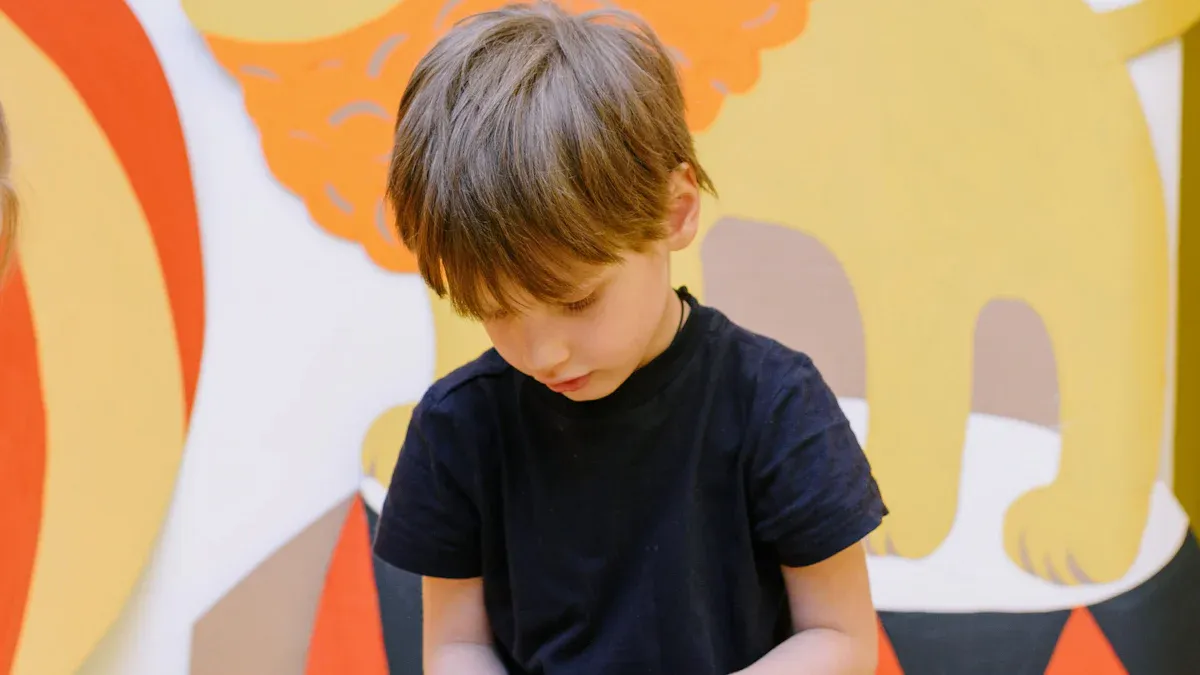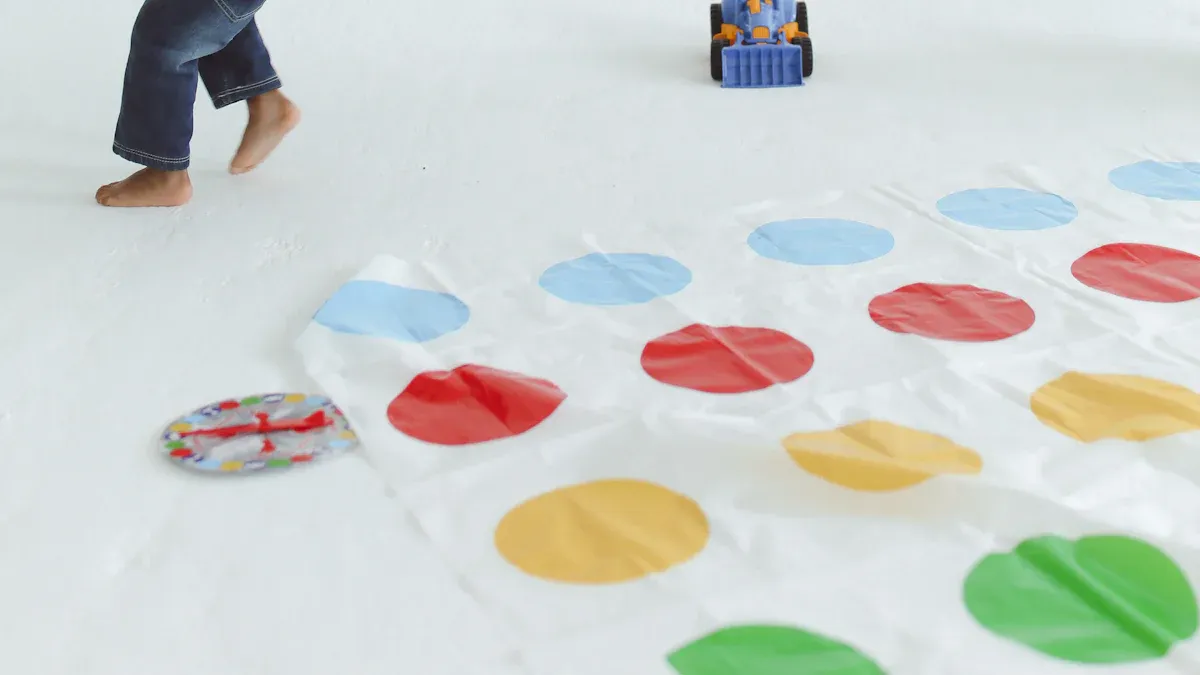You can teach color recognition during daily routines. Point out colors when you set the table. Show colors when you pick out clothes. Begin with bright primary colors. Use nature walks, meals, and playtime to teach colors. Sorting and matching colors helps kids learn and remember. Sensory play and movement help your toddler learn colors. Every child learns at their own speed, so keep it fun and relaxed.
Key Takeaways
- Add color learning to everyday activities. Show colors at meals, while shopping, and on walks outside. This makes learning easy and fun.
- Play games like I Spy and do sorting tasks. These games help your child stay interested. Fun activities help your child remember colors.
- Praise your child for learning colors. Giving praise helps your child feel good. It also makes them want to learn more.
Challenges

Common Struggles
You might notice that teaching colors does not always go as smoothly as you hope. Many parents run into a few common struggles:
- Colors can be a complex idea for young children. Red and orange may look the same to them at first.
- Toddlers often have short attention spans. They may lose interest quickly if an activity feels boring or too hard.
- Keeping your child engaged takes creativity. You need to find fun ways to hold their interest.
Some children also face extra challenges. Developmental differences, such as color blindness or autism, can make color recognition harder. Your child may mix up shades or have trouble seeing colors in different lighting. This is normal. Their brains are still learning how to process what they see.
Tip: If you feel concerned about your child's progress, talk to your pediatrician. Early support can make a big difference.
Realistic Expectations
You may wonder when your child will start naming colors. Most toddlers begin to recognize colors around 18 months. By age three, many can name at least one primary color. Every child learns at their own pace. Some need more time, especially if they struggle with visual perception or have developmental delays.
Try not to worry if your child confuses colors or forgets names. Color recognition is a gradual process. Celebrate small wins and keep lessons playful. Your encouragement helps your child feel confident and excited to learn.
Teaching Color Recognition

Identify Colors in Nature
Nature gives many chances to see colors. Go outside and look for leaves, flowers, or birds. Bring color cards and ask your child to match them. Try a color hunt in your yard or at the park. Point out the green grass, blue sky, and yellow dandelions. Real-life examples help your child spot colors every day. Use sidewalk chalk to draw colored circles. Let your child jump on the right color when you say it. Talk about the red of strawberries or orange of carrots during snacks.
Tip: Say color names when shopping or at traffic lights. These moments help your child remember colors in real life.
Toddler Color Games
Games make learning colors fun. Play Candyland to practice color recognition and visual discrimination. Try I Spy and give clues about colors. Your child can find matching things in the room. These games help your child notice many colors around them. Use colorful blocks or sorting toys during play. Digital games like the ABC Rainbow App teach colors and other skills. Too many bright colors can distract your child. Keep the play area simple if your child loses focus.
Some fun ways to practice color recognition are:
- Sensation squish bags with colorful things for a sensory experience.
- Outdoor color hunts, like picking leaves or rocks of different colors.
- Matching games with colored objects and flashcards.
- Interactive games like Butterfly Catcher: Secondary Colors from ABCmouse.
Painting and Drawing
Art time is great for teaching color recognition. Give your child paints, crayons, or markers in basic colors. Let them make art. Painting lets your child feel textures and learn about mixing colors. When they mix blue and yellow, they see green. Ask your child to name each color as they use it. This helps them remember color names and learn new words. Studies show art helps kids use more colors in their drawings. Over time, your child will notice more colors, even ones they missed before.
- Let your child paint with fingers or brushes.
- Use coloring pages that focus on one color.
- Talk about the colors your child picks and ask them to describe their art.
Sorting and Matching
Sorting and matching are great for teaching colors. Use toys, blocks, or socks from the laundry. Ask your child to group things by color or match items that look the same. Sensory bins with colored rice or objects make it more fun. Sticker sorting with dot stickers is another easy way to practice. These activities help your child match colors and pay attention.
| Activity Type | Description |
|---|---|
| Matching Colors | Children can match colors by putting button hats on dowel people. |
| Sorting by Color | Sorting means grouping things by color, which helps toddlers learn color recognition. |
| Sensory Bins | Sensory bins with certain colors let toddlers explore and notice color differences. |
| Sticker Sorting | Sorting dot stickers is a fun way for toddlers to learn about colors. |
Sorting and matching games help your child think, talk, and use their hands. When your child sorts, they learn to group and remember colors. Group games can also help your child learn to work with others.
Reading Color Books
Reading books together is a great way to teach colors. Pick books with bright pictures and simple, repeating words. Books like "Brown Bear, Brown Bear, What Do You See?" and "Pete the Cat: I Love My White Shoes" are favorites. These books help your child spot colors and link them to things they know. Many color books focus on one color at a time, which makes learning easier. Reading these books often can help your child learn colors and enjoy storytime.
| Book Title | Author | Effectiveness for Color Learning |
|---|---|---|
| Brown Bear, Brown Bear, What Do You See? | Bill Martin, Jr. | Simple and repetitive, great for identifying colors. |
| Pete the Cat: I Love My White Shoes | Eric Litwin | Bright pictures and repetitive text, popular among toddlers. |
| Bear Sees Colors | Karma Wilson | Fun story that teaches basic colors through rhymes. |
| The Artist Who Painted a Blue Horse | Eric Carle | Bright pictures and imaginative colors, effective for color identification. |
| Books about colors | Keith Baker | Focused on a particular color with large text, effective for teaching colors. |
Note: Colorful children’s books mix fun stories with bright pictures. This helps your child learn and remember colors.
By adding these color activities to your daily routine, learning feels easy and fun. Start with basic colors like red, yellow, and blue. Add more colors as your child grows. With nature walks, games, art, sorting, and reading, your toddler will learn color identification skills quickly.
You can make color learning part of your everyday life. Try these proven methods:
| Method | How It Helps |
|---|---|
| Sorting or matching | Builds color skills with hands-on play |
| I Spy game | Makes color spotting fun and interactive |
| Color by code sheets | Mixes learning with creativity |
- Celebrate every small win. Give high-fives, hang up their art, or start a “Success Wall.” Keep it playful and watch your toddler’s confidence grow! 🎨
FAQ
When should I start teaching my toddler colors?
You can start as soon as your child shows interest. Most toddlers begin to notice colors around 18 months. Keep it playful and relaxed.
What if my child keeps mixing up colors?
That is normal. Many toddlers confuse colors at first. Keep practicing with games and daily routines. Celebrate small wins to build confidence.
Do I need special toys or tools to teach colors?
No, you do not. Everyday items like clothes, food, and books work well. Use what you have at home to make learning fun.









